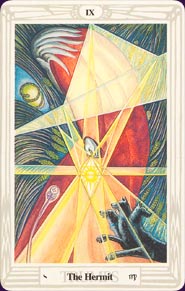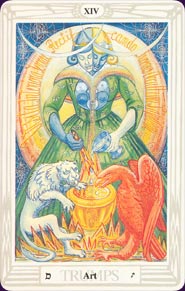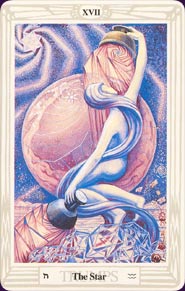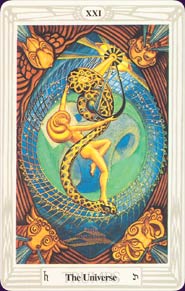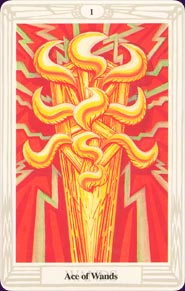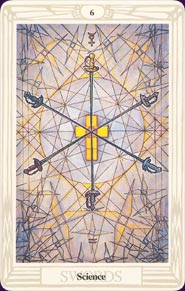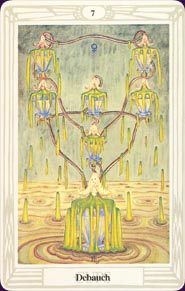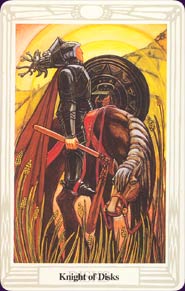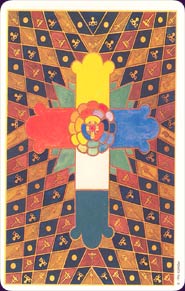Aleister Crowley Thoth Tarot Deck Review
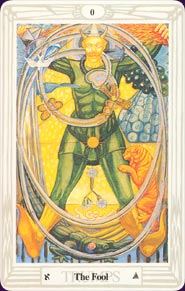
The striking, fascinating artwork in the classic Aleister Crowley Thoth Tarot was conceptualised by the famous occultist and Golden Dawn member, Aleister Crowley, and created by Lady Frieda Harris. This edition of the deck has 80 cards, which includes three versions of the Magus card.
Deck Type: Tarot Deck Cards: 80
Creators: Aleister Crowley, Frieda Harris
Publisher: US Games 1978
Retailers
See Price at Amazon.comSee Price at Amazon.co.uk
Aleister Crowley Thoth Tarot Review by Bayati
In spite of the bad rap this deck sometimes receives (perhaps because it is preceeded by the reputation of its infamous creator), for me there is no other deck that provides me with such profound clarity and accurate guidance in readings. Though I own and have read several other decks, for the past three years, this is the only deck I use for readings.
When I saw this the complete deck for the first time in a local Metaphysical store, its flaming intensity scared me. There is a richness and complexity to it that both attracts one to its bold beauty and causes the same aversion the eyes feel when looking at the sun. Just as the eyes can't handle the intense rays of the sun, in my earliest tarot studying days, I wasn't quite ready for the Thoth.
A month later, I broke down and bought the cards, and in spite of their complexity (and perhaps because of it), found them the easiest to read. Each card is filled with a myriad of archetypal symbols, each adding to a potential meaning of the card. Simpler decks, with just one main image didn't really work for me because I found their possible interpretations too limiting. But, as I began to learn the Thoth, I often found myself inexplicably drawn to a certain aspect of the card (a symbol, a color, a picture) that would tend to add more specificity or color to the card's standard meaning. In decks with more straight-forward images, such as those in the Osho Zen deck (which I used to use in readings), I always felt my readings were too generalized.
I was a novice at the tarot when I first began using this deck. Some may not reccommend it for beginners because of the Thoth's heavy ties to Egyptian spirituality, Astrology, and the Kabbalah. I disagree. I still know nothing about the Kabbalah, and very little of the Egyptian references, but do not feel that my readings suffer because of it. The potency in this deck lies in its images.
However, a beginner (or master of the tarot for that matter) should have a good book to use as a reference. Crowley's Book of Thoth is not one I'd recommend for anyone who wants to learn how to read these cards. Generic tarot books won't work for card meanings either. I own several books that specialize in this deck, and my favorite by far is Tarot Mirror of the Soul by Gerd Zeigler. It is one of the most concise books for this deck, yet it addresses nearly all of the details and symbols found in each card. It also has a picture of each card on the same page as its meaning, which is helpful.
In short, this deck offers infinite variations in meaning that results in more specific readings. Don't be thrown off by its complexity or the superstition surrounding it. They are just cards, but they are wonderful ones. I give this deck five stars.
Aleister Crowley Thoth Tarot Review by similia
One of the classics of modern tarot, Aleister Crowley’s Thoth Tarot has remained one of the most popular decks available for decades. Printed in numerous editions and numerous sizes (with new editions on the horizon) the appeal of this deck cannot be underemphasized. Since its initial publication in 1969 it has attracted a steady stream of acclaim for its striking beauty, as well as its depiction of an understanding of occult knowledge that was gained over a lifetime of devoted study.
It should be said that the Thoth has the distinction of being one of the most controversial tarot decks available also. On occasions you hear people refer to the deck as “dark”, probably because of the reputation cultivated by its creator. It certainly doesn’t have the instant personable appeal of decks like the Fey, or the fluffy bunny cuteness of some others, but as an illustrated guide to the fundamental features of us and our world, it presents a balanced view.
Conceived and executed by artist Lady Frieda Harris under the instruction of the controversial magician Aleister Crowley, The Thoth Tarot was in fact not published during the lifetimes of its creators. The Book of Thoth, a guide to the tarot written by Crowley and illustrated with Harris’s paintings was published and is still available today, both as a book and freely over the internet at numerous websites. While The Book of Thoth is a wonderful book, that I recommend unreservedly for anyone who owns the Thoth Tarot it may not the best place to start your studies. Instead I’d suggest Lon Milo Duquette’s Understanding Aleister Crowley’s Thoth. Duquette will not teach you the standard meanings of the cards, but he will teach you how the system works, where it comes from, and where to go next. Even if you have no interest in astrology, qabalah, magic, Egyptian mythology, alchemy etc…you can still get much of value from this deck. My experience however was that the decks ability to expand my areas of interest and knowledge was one of its most attractive features.
The Thoth Tarot is based on the Golden Dawn tradition, and for those familiar with the Rider Waite deck, or any Golden Dawn derivative, much of the deck will be immediately familiar. Each of the cards has the astrological and qabalistic attributions illustrated within the card image itself, as well as depicted on the card’s border. The minors also have the esoteric title written on the bottom. The deck can of course be used without these systems, but I have found studying them to be immensely rewarding personally, as well as to my knowledge of the tarot. These same features can then be applied to any deck, but are most clearly visible and beautifully rendered in the Thoth itself.
The minors do not contain illustrated scenes as in the Rider Waite Smith style, they are however highly illustrated. Harris’s pips evoke the intention of the card clearly, most meanings being similar to the Rider Waite Smith. For example while the RWS Two of Wands shows a man holding the world in his hand as he overlooks his kingdom; the Thoth Two of Wands (titled Dominion) shows us two Tibetan Djores crossed in front of burning flames, symbols of great power and authority. The glyphs for Mars and Aries appear on the card, telling us the card belongs to that sign and planet, which reinforces the meaning of strength, courage, pride etc…
One of the differences between the Thoth deck, and other well known decks such as the Rider Waite Smith, Marseille or Golden Dawn decks is the court cards. The courts are virtually identical pictorially to those of the Golden Dawn (Golden Dawn Tarot, Golden Dawn Magical Tarot etc.) and are based on the features described in Book T (a piece of Golden Dawn literature on the tarot). In the Golden Dawn tradition there are the standard four court cards. Kings (shown riding on a horse), Queens (seated on a throne), Princes (drawn forth in a carriage) and Princesses (standing). Crowley has maintained these features, but caused much confusion by renaming his “Kings” Knights in order to better represent the virility of the character. For someone used to the RWS or Marseille style Courts in which the King and Queen are both seated, and the Knight is the figure on the horse this can be initially confusing. A King riding a horse is now a feature I look for in a tarot deck when adding to my collection irrespective of the title given to him.
The majors also have been changed in some areas. A number of cards have been renamed to better reflect Crowley’s understanding of the deeper meanings of the card i.e. The Magus (magician), The Priestess (high priestess), Adjustment (justice, numbered 8), Fortune (wheel of fortune), Lust (strength, numbered 11), Art (temperance), The Aeon (justice) and The Universe (the world). While most of the images of the majors are similar to other decks (at least in basic composition) a number of cards have been radically altered to reflect Crowley’s magical journey and better illustrate his understanding of the modern world. Cards such as Lust, The Devil and especially The Aeon stand out in this regard.
The Thoth Deck is available in multiple sizes. At 14cm (5 1/2 inches) high and 9.5cm (3 3/4 inches) wide the larger deck may be too big for many people to shuffle comfortably. It does have the benefit of making the rich details of the card clear, which aids study. The smaller sizes are a very comfortable shuffle and the images do not suffer unduly from the reduced size. The card back shows a stylised Rosicrucian Cross, and is not reversible (the Thoth deck not being intended to be reversed).
The Thoth deck may not appeal to all people, but if you are attracted to this deck at all I highly recommend adding it to your collection. It will aid you in studying the tradition of modern tarot in greater detail and will enhance your knowledge and use of any other decks in your collection.
Aleister Crowley Thoth Tarot Review by Bonnie Cehovet
“The symbolism, traditional postures, attribution
of the cards, and the planetary, zodiacal, and elemental
colours have been given to me by an expert who has studied
the Tarot for forty years, and to whom my thanks are due
for his courteous co-operation.”
Lady Frieda Harris
July, 1942
I feel like I am light years behind in reviewing this deck, which, along with the Rider-Waite-Smith deck, is not only a popular deck, but a classic Tarot deck. Originally published in 1969, it has since come out in several different sizes and versions (including varied coloring). (Note: The deck was not published in the lifetimes of either Aleister Crowley or Lady Frieda Harris, aside from a limited edition of 200 copies that Lady Frieda Harris herself had printed.)
The deck that I am reviewing is the 2006 edition from US Games, Inc. It comes in a beautiful lavender colored box (as opposed to the cream colored version), and includes an 80 card deck (there are three versions of the Magus), a 20” by 17” spread sheet for the Celtic Cross spread, and a 48 page instruction booklet (LWB – Little White Book) by James Wasserman. The LWB was edited and updated by Lynn Araujo, and includes two essays written by Lady Frieda Harris, along with commentary by Stuart R. Kaplan.
The back of the sleeve that the box comes in shows images of the Hierophant and the Star, along with a short background on the deck. The back of he box that holds he deck contains concise biographies of Aleister Crowley and Lady Frieda Harris.
This is a controversial deck, to be sure – in large part because Crowley himself is such a controversial figure (by choice). The deck was begin in 1938, and completed in 1943. Traditional Tarot symbolism was revised along highly esoteric lines, based on Crowley’s own esoteric theories. (Note: Crowley was a member of the Hermetic Order of the Golden Dawn, as was Lady Frieda Harris.)
This deck is so heavily esoteric that it can be hard to understand. Crowley wrote a guidebook to the deck, entitled “The Book of Thoth”, which was illustrated with Frieda Harris’s images. Quite frankly, it is not an easy book to follow. (Crowley likes to hear himself talk.) Other books that may be a bit easier to understand are Lon Milo DuQuette’s “Understanding Aleister Crowley’s Thoth Tarot”, or Gerd Ziegler’s “Tarot: Mirror of the Soul”.
The LWB starts out with the background of the deck, followed by a section on the background of Tarot, connecting it strongly to the Kabbalah and the Tree of Life. The suggestion is made that the reader should give an invocation to higher forces before doing a reading (or, alternately, visioning a radiant white light purifying and exalting consciousness). The following is offered as a sample invocation”
“I invoke Thee, IAO, that Thou wilt send HRU, the great Angel that is set over the operation of this secret Wisdom, to lay his hand invisibly on these consecrated cards of art, that thereby we may obtain true knowledge of hidden things to the glory of thine ineffable Name. Amen.”
There is a fifteen card template (laid out in five groups of three) presented in the that acts as an alternative to the classic ten card Celtic Cross spread.
The card meanings are presented in brief form, text only (no scans). For example:
0 The Fool. In spiritual matters, represents ideas and thoughts, which endeavor to transcend earth. In material matters, reveals folly, eccentricity, even mania. It represents a sudden, unexpected impulse.
Knight of Cups. The fiery part of water. A man with commitment issues. Amiable but passive. Attracted to excitement. Unsustainable enthusiasm. Sensitive but shallow. Influenced: Sensual and idle, untruthful, prone to depression and drug abuse.
Note: In the Thoth Tarot the Knight takes the place of the King.
Two of Swords. Peace. Dual nature. Sacrifice and trouble giving birth to strength. Conflict leading to peace. Pleasure after pain. Truth and untruth. Indecision. Ambivalence.
Stuart Kaplan provides a very nice introduction to the essays, indicating that the first essay, “Exhibition of Playing Cards – The Tarot (Book of Thoth), 78 Paintings”, was probably edited by Lady Frieda Harris from Crowley’s writings, while the second essay, “Exhibition of 78 Paintings of the Tarot Cards”, written for an art exhibition at Berkeley Galleries, was written by Lady Frieda Harris.
Traditional titles are used for the Trumps (Major Arcana), with the following exceptions: Magus (Magician), Adjustment (Justice), Fortune (The Wheel of Fortune), Lust (Strength), Art (Temperance), and Aeon (Judgment). The four suits are Wands, Cups, Swords, and Disks. The Court Cards are Knight, Queen, Prince and Princess.
The artwork itself shows the influence of both art deco and projective geometry (through the work of Rudolf Steiner). Instead of the usual straight or curved lines, when we look at the Thoth deck we see arcs, sworls, and geometric forms overlaid in a stunning pattern, made more so through the use of color. It is like stepping into another dimension to look at this deck, much less to read with it.
The card that departs the most from traditional imagery is that of Aeon. In place of the trumpeting Angel we see stylized figures of the deities from the Stele of Revealing and “The Book of the Law”.
The cards themselves are 2 7/8” by 4 3/8”, of good quality card stock. The card backs image on the card backs is that of the Rose Cross, surrounded by a white border. This is Lady Frieda Harris’s interpretation of the Hermetic Rose Cross. Within this cross is represented all 78 cards of the Tarot.
The card faces show a narrow white outer border, followed by a gray inner border. For the Major Arcana, the Roman numeral is centered at the top of the card, with the card title, astrological glyph and Hebrew letter, at the bottom. (Note: I have one small gripe here: the titles are in black letter, with light gray lettering behind them reading Trumps (for the Major Arcana), and the suit name for the Minor Arcana. It is a bit annoying.) For the Pips (numbered cards), the number in Arabic numerals is at the top of the card, with the esoteric title at the bottom of the card. For the Court cards, title and suit is placed at the bottom of the card.
The Fool for me is quite a startling card – in place of a rather ephemeral being, we see quite a strong individual, arms raised, bearing a sphere containing Illusion in his left hand, a staff in his right hand, over his right shoulder. At his feet are a lion and a dragon.
The Two of Cups (esoteric title Love), is beautifully portrayed by two fountains of water (silver on the left, gold on the right).
Note: The Pips are not illustrated as such – they closely follow the Marseille tradition of using icons only with a few additions.
The Three of Wands (esoteric title Virtue) shows three gold wands crossed in the center of the card, against a bright orange background.
The Four of Swords (esoteric title Truce) shows four swords in the center of the card, tips pointed towards the center) against an emerald green background, with a lavender rose with white rays.
The Ace of Disks is a geometric wonder! Incorporated into this card are five concentric circles, with a yellow circle in the center. In the center of the circle we see both a hexagram and a pentagram.
For those students interested in the Golden Dawn, or in esoteric imagery, this is a wonderful deck to study. For those wishing to simply collect the deck, or use it for journeying or guided imagery, this is also an excellent deck. I would highly recommend purchasing DuQuette’s book along with the deck (rather than, or in addition to, Crowley’s own Book of Thoth), because it is much easier to follow!
© Bonnie Cehovet
Complete Details of Aleister Crowley Thoth Tarot
Also known as Thoth Tarot, Crowley Thoth Tarot, Toth Tarot
Creators: Aleister Crowley, Frieda HarrisPublisher: US Games 1978
Deck Type: Tarot Deck
Cards: 80
Major Arcana: 24
Minor Arcana: 56
Deck Tradition: Crowley Thoth
Minor Arcana Style: Thoth-Based
Suits: Cups, Swords, Wands, Disks
Court Cards: Princess, Prince, Queen, Knight
Major Titles: The Fool, The Magus, The Priestess, The Empress, The The Emperor, The Hierophant, The Lovers, The Chariot, Adjustment, The Hermit, Fortune, Lust, The Hanged Man, Death, Art, The Devil, The Tower, The Star, The Moon, The Sun, The Aeon, The Universe
The Fool is 0
Strength is 11
Justice is 8
Card Size: 2.76 x 4.33 in. = 7.00cm x 11.00cm
Card Language: English
Card Back: Non-reversible
Back Design: Multi-coloured rosicrucian cross on a checkered background.
Companion Material: 48-page companion booklet with this edition.
Rating: 20/20 or
Similar Decks to Aleister Crowley Thoth Tarot
Theme: Golden Dawn, Occult, Shadow Work, Thoth-InspiredCategory: Available Tarot Decks, Popular Tarot Decks, Tarot Decks With Extra Major Arcana
Creator: Aleister Crowley Thoth Tarot Pocket Edition by Frieda Harris Aleister Crowley Thoth Tarot Pocket Edition, The Complete Tarot Kit by Aleister Crowley
< Previous Deck · Back to Top · Next Deck >
Home > Tarot Reviews > Aleister Crowley Thoth Tarot Review

